Our master’s thesis “human like machine like human” examines automation, design and the entanglement of man and machine. Instead of regarding machines exclusively as destroyers of human jobs, we investigate how humans and machines are actually getting closer to each other.
2018
Master’s thesis
in collaboration with
Yannic Sturm
In five explorations we examine the humanity in the machine, which in turn reflects the machine-ness in us humans. We look at how machines learn, show that they can make mistakes just like we do, and investigate whether they are capable of being funny, creative and poetic.
01
Greetings from the Uncanny Valley
This preliminary investigation spans almost 100 years of robot history and contains over 160 illustrations of “human like machine(s)”: machines that look like humans.
One of the most striking aspects of many of these human-like machines is the Uncanny Valley. This “Uncanny Valley” appears when machines look very human-like, but not similar enough to pass for real humans. This discrepancy between the appearance of the machine and the mental image we have of a human being makes many viewers uneasy. It is still controversial whether the valley should be traversed with force or if it better be avoided altogether.
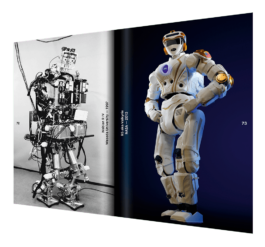
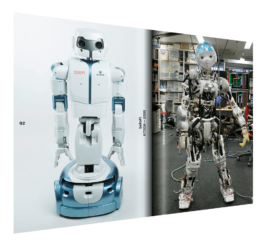
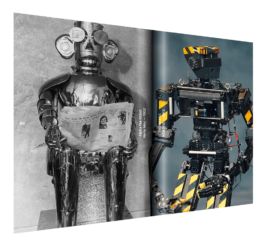
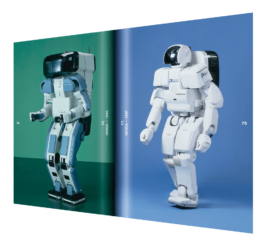
02
Katzen erkennen lernen
The book “Katzen erkennen lernen” (Learning to recognize cats) deals with how machines learn. It contains 5,000 images of cats with which an image recognition algorithm is trained.
With this sheer mass of images we wanted the reader to understand and almost physically experience what a machine must accomplish in order to be able to recognize something so ostensibly simple like a cat. At the same time, the project also reflects in a certain way how humans learn. Just as a machine initially has no “inherent idea” of a cat, it can take a newborn human being years to learn and master skills such as seeing, grasping or speaking.
03
artificialhumanerror.jsx
In our third project we dealt with fallibility as a typically human trait and with the question of whether this trait can be transferred to machines that might thereby become more human.
The InDesign script artificialhumanerror.jsx adds typical human errors to a layout — such as spelling mistakes or accidentally moved images and text frames. By parameterizing human properties, the script allows a specifically human “style” to be exaggerated beyond the limits of what is humanly possible and to explore a new visual aesthetic.
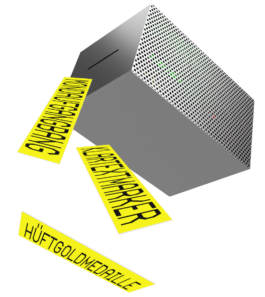
04
autopoet
The “autopoet” is our attempt at building a machine that can produce wit and poetry.
The algorithm has a dictionary with over 64,000 German nouns. By systematically checking the overlapping of the respective word ends and beginnings, the machine can generate new portmanteau words that are often funny and sometimes almost poetic.
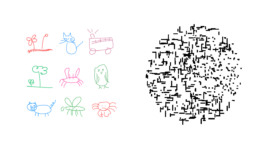
05
Can machines think?
The study “Can machines think?” derives its leading question from the groundbreaking essay “Computing Machinery and Intelligence” by computer pioneer Alan Turing. We make it enable the viewer to explore this question for oneself and to possibly answer it.
In a catalogue we show a series of pictures, half of which were created by humans and half by machines. By not creating order in the sequence of images and only clarifying the character of the images on the back, we encourage a naïve look at the images that shows how much the boundaries between man and machine have started to blur.
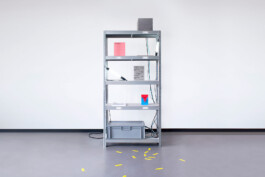
Our master’s thesis “human like machine like human” examines automation, design and the entanglement of man and machine. Instead of regarding machines exclusively as destroyers of human jobs, we investigate how humans and machines are actually getting closer to each other.
In five explorations we examine the humanity in the machine, which in turn reflects the machine-ness in us humans. We look at how machines learn, show that they can make mistakes just like we do, and investigate whether they are capable of being funny, creative and poetic.
in collaboration with Yannic Sturm
2018
Greetings from the Uncanny Valley
This preliminary investigation spans almost 100 years of robot history and contains over 160 illustrations of “human like machine(s)”: machines that look like humans.
One of the most striking aspects of many of these human-like machines is the Uncanny Valley. This “Uncanny Valley” appears when machines look very human-like, but not similar enough to pass for real humans. This discrepancy between the appearance of the machine and the mental image we have of a human being makes many viewers uneasy. It is still controversial whether the valley should be traversed with force or if it better be avoided altogether.
Katzen erkennen lernen
The book “Katzen erkennen lernen” (Learning to recognize cats) deals with how machines learn. It contains 5,000 images of cats with which an image recognition algorithm is trained. With this sheer mass of images we wanted the reader to understand and almost physically experience what a machine must accomplish in order to be able to recognize something so ostensibly simple like a cat. At the same time, the project also reflects in a certain way how humans learn. Just as a machine initially has no “inherent idea” of a cat, it can take a newborn human being years to learn and master skills such as seeing, grasping or speaking.
artificialhumanerror.jsx
In our third project we dealt with fallibility as a typically human trait and with the question of whether this trait can be transferred to machines that might thereby become more human.
The InDesign script artificialhumanerror.jsx adds typical human errors to a layout — such as spelling mistakes or accidentally moved images and text frames. By parameterizing human properties, the script allows a specifically human “style” to be exaggerated beyond the limits of what is humanly possible and to explore a new visual aesthetic.

The “autopoet” is our attempt at building a machine that can produce wit and poetry. The algorithm has a dictionary with over 64,000 German nouns. By systematically checking the overlapping of the respective word ends and beginnings, the machine can generate new portmanteau words that are often funny and sometimes almost poetic.
Can machines think?
The study “Can machines think?” derives its leading question from the groundbreaking essay “Computing Machinery and Intelligence” by computer pioneer Alan Turing. We make it enable the viewer to explore this question for oneself and to possibly answer it.
In a catalogue we show a series of pictures, half of which were created by humans and half by machines. By not creating order in the sequence of images and only clarifying the character of the images on the back, we encourage a naïve look at the images that shows how much the boundaries between man and machine have started to blur.
